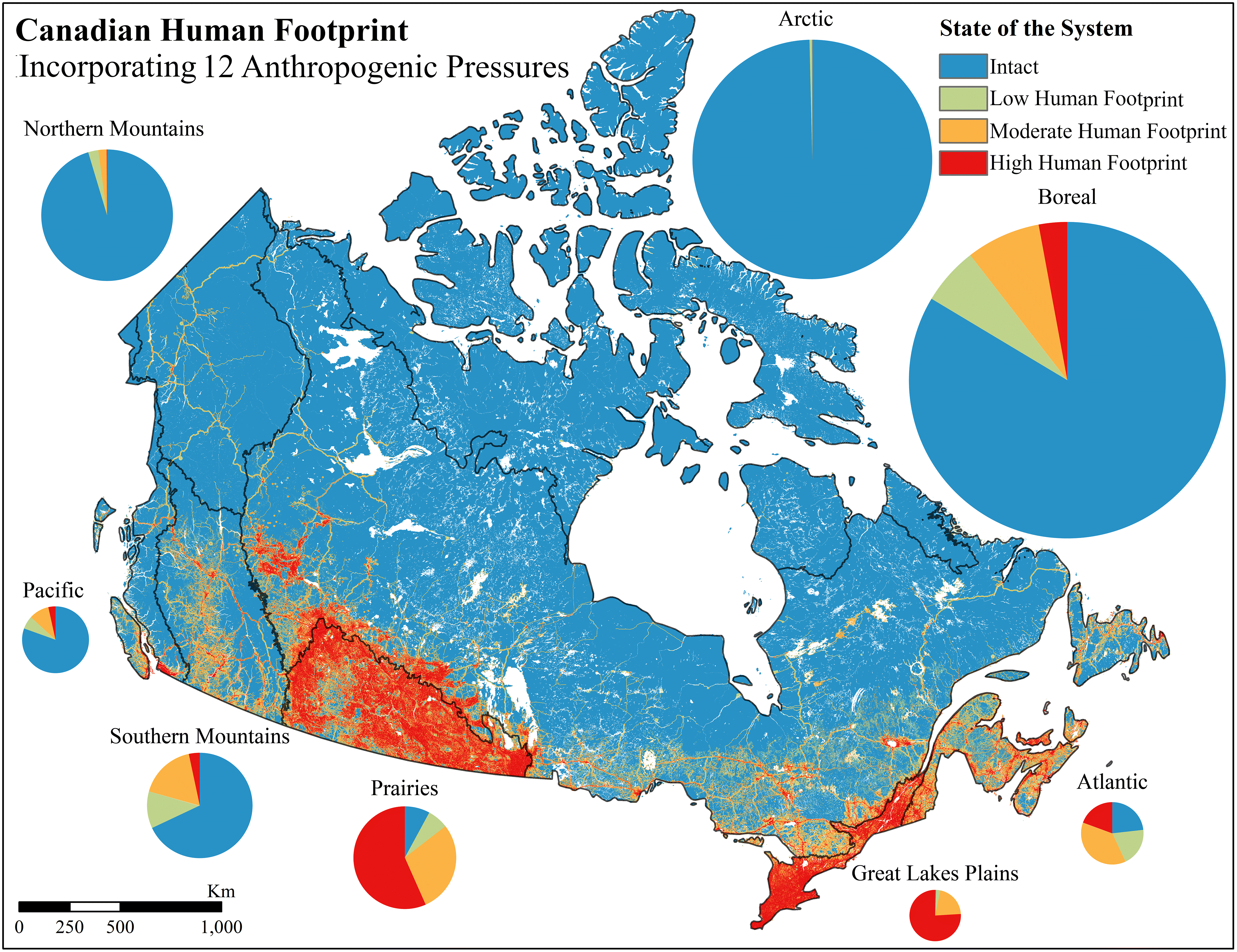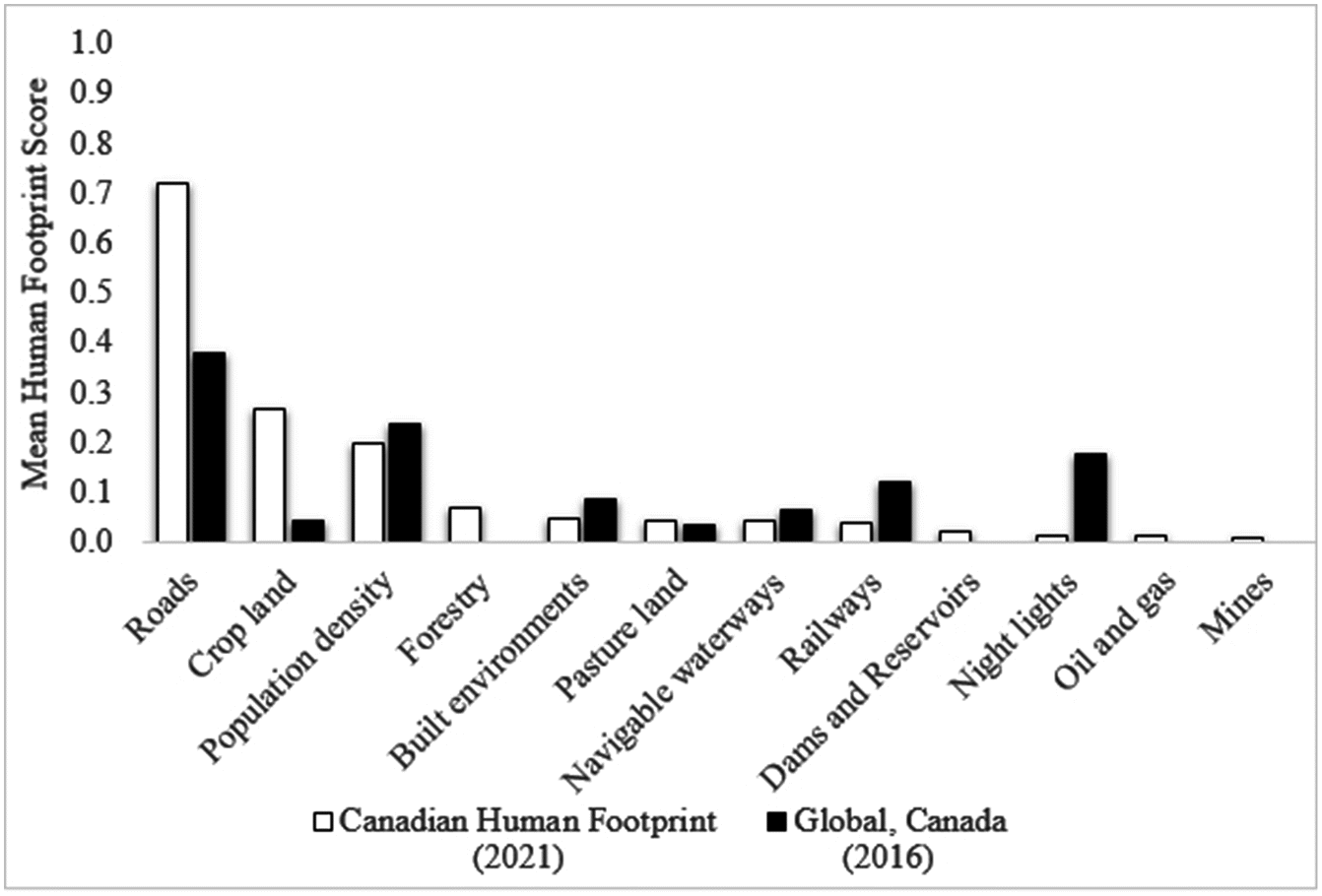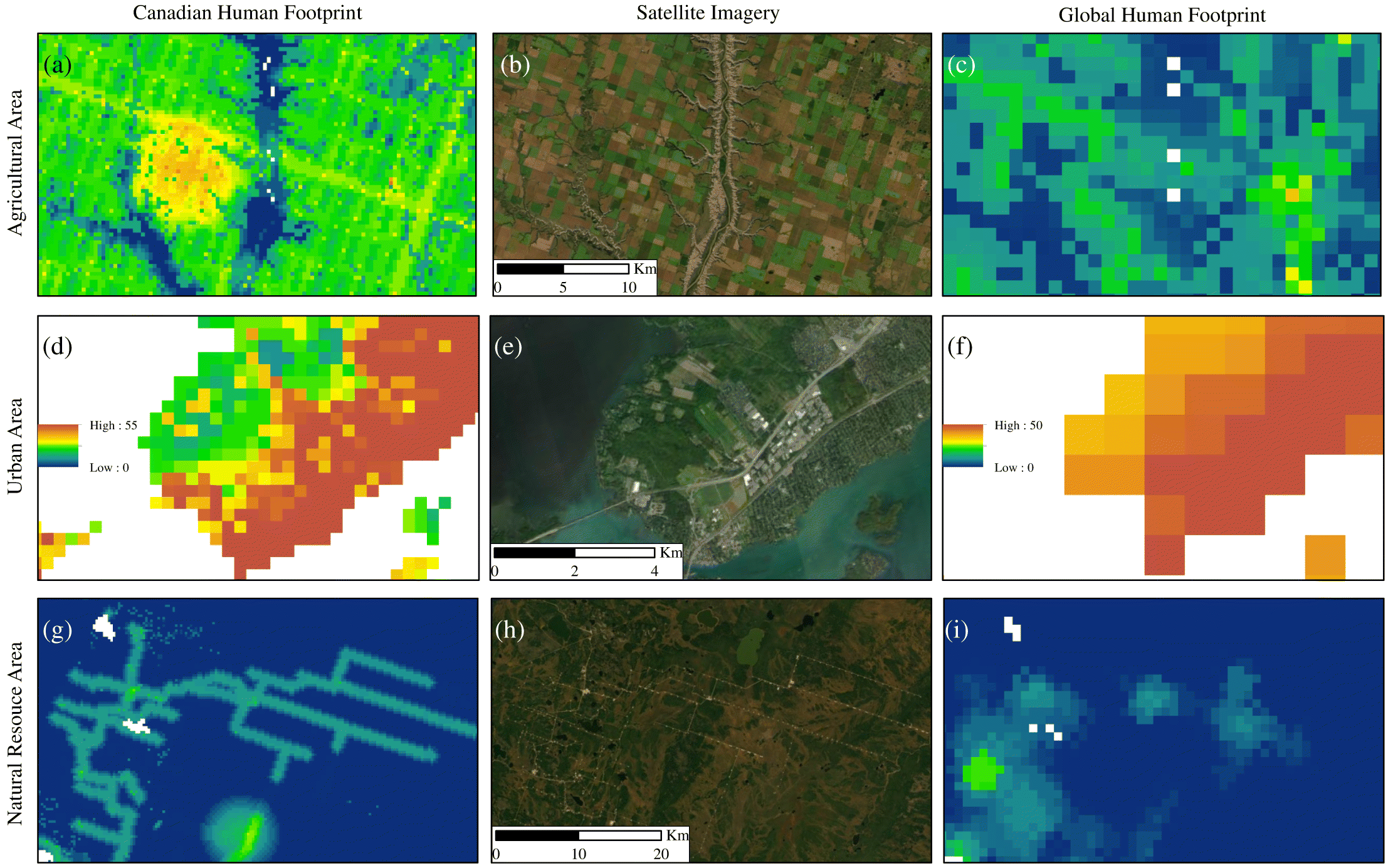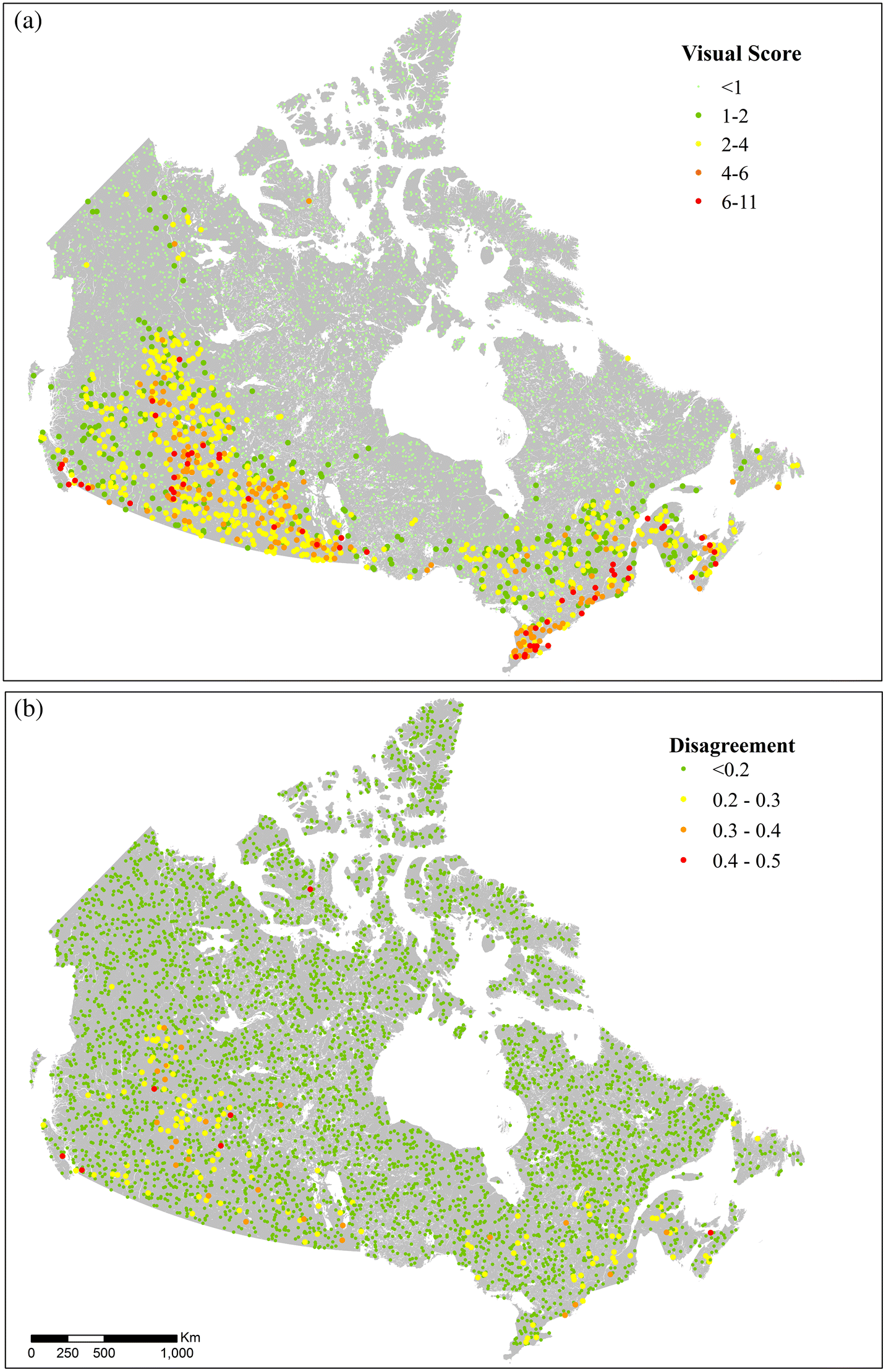Introduction
When pressures are analysed, especially those from resource development projects, the focus is often on the project in isolation of other developments (
Duinker and Greig 2006;
Johnson 2016;
Sinclair et al. 2017;
Westwood et al. 2020). By incorporating more than one pressure, it is possible to develop a more complete understanding of the interacting pressures on biodiversity, with the potential to assess the impacts for ecosystem services (
Halpern et al. 2008). Cumulative pressure mapping allows for the combination of more than one pressure to show the full extent and intensity of anthropogenic pressures (
Tapia-Armijos et al. 2017). Cumulative pressure maps, also known as human footprint maps, combine pressures into a single product that can be used to yield the greatest conservation benefit, including directing development to areas that will cause the least amount of harm to the system (
Crain et al. 2009;
Venter et al. 2016a).
Canada’s natural systems have a number of pressures that negatively affect biodiversity.
Woo-Durand et al. (2020) analysed pressures to 820 species identified as “at risk” by the Committee on the Status of Endangered Wildlife in Canada (COSEWIC). They found that the number of pressures affecting each species has increased significantly from an average of 2.5 to 3.5 between 1999 and 2018. Such findings highlight the need to map pressures in Canada cumulatively and not in isolation (
Venter et al. 2006;
Woo-Durand et al. 2020). Nevertheless, no cumulative pressure map covers the entirety of the country. At present, Canada has cumulative pressure maps for parts of the coastal waters (
Ban and Alder 2008;
Ban et al. 2010;
Clarke Murray et al. 2015a,
2015b) and two studies covering freshwater (
Robb 2014;
Sterling et al. 2014). For terrestrial studies, the greatest coverage spans the largest ecological area of Canada, the Boreal/Taiga (
Pasher et al. 2013). Other terrestrial maps cover sections of western Canada (
Mann and Wright 2018;
Shackelford et al. 2017), part of eastern Canada and the United States (
Woolmer et al. 2008), and the whole of Canada to display the number of pollution pressure categories present (
McCune et al. 2019). In addition to human footprint maps, a map exists showing the presence and absence of access into nature across Canada (
Lee and Cheng 2014). However, a simple map of access does not fully represent the spectrum of human pressures, such as the contrast between large metropolitan cities and smaller resources centric towns (
Lee and Cheng 2014), or landscapes under pressure from resource extraction. Global human footprint maps display Canada as mostly intact (
Sanderson et al. 2002;
Venter et al. 2016a,
2016b); however, that includes only a subset of pressures relevant to the country, missing critical data for the Canadian context such as mining and forestry, though more recent global updates have taken place (
Jacobson et al. 2019). Therefore, until a national human footprint is produced, there will continue to be a gap in our understanding for the Canadian human footprint.
As a signatory of the Convention on Biodiversity and its Aichi Biodiversity Targets, Canada’s Target 1 is to protect 17% of terrestrial and 10% of marine areas (
MacKinnon et al. 2015). With this ambitious conservation target there is a need to better understand the distribution of pressures to natural systems across Canada. A nationwide map of human pressures is important for identifying the ecosystems that are most intact and the areas with the greatest intensity of human pressures. Intactness is defined as landscapes that maintain biological and ecological function and are mostly free of nonindigenous human pressures. This definition does not exclude Indigenous Peoples and their stewardship practices, but it does exclude large-scale land conversion, human activity, and development (
Waller and Reo 2018;
Watson et al. 2016). Mapping the human footprint will serve as an important step in selecting which areas to protect, restore, and sustainably manage.
Here, we used geospatial techniques to develop a map for Canada that represents nationally specific pressures across our ecological areas that are not incorporated in coarse-scale global maps. Using a higher spatial resolution of 300 m, we produced the first national terrestrial human footprint of Canada. We visually and quantitatively compared the global and national products and identified improvements and errors in the representation of human pressures. We used high-resolution satellite imagery to validate the accuracy of the final footprint map. As the maintenance of biodiversity and ecosystem services depends on the comprehensive understanding of the full set of overlapping pressures (
Sala et al. 2000), the results of this project will be important for identifying future conservation lands across Canada as well as ecosystems that are in need of protection and restoration.
Mining
Mining often alters topography and watercourses and removes topsoil as a form of land conversion. Mining can be a point source for air and water pollution (
Woolmer et al. 2008). We used the mines and minerals data set, updated in 2015, to obtain all active mines in Canada. The data were discrete points in vector format (
Government of Canada; Natural Resources Canada 2017). We placed the mineral groups in their designated categories: open large, open small, underground large, and underground small (
WWF Canada 2003). For the minerals that were not previously classified by
Woolmer et al. (2008) we consulted with an expert to determine if the mineral group would be mined underground or in an open pit (McGill, personal communication, 31 October 2018). Once confirmed to be open or underground, we placed them all in the small category, for open pit and underground mining, as a way to make sure we did not over-estimate the pressure. The scoring from
Woolmer et al. (2008) was used for mines (
Table 5).
Oil and gas
Oil and gas production have a number of associated pressures to nature such as wildlife mortality, habitat fragmentation and loss, noise and light pollution, introduction of invasive species, and sedimentation of waterways (
Brittingham et al. 2014;
Jones et al. 2015). The mines and minerals data set, updated in 2015, was used as it lists active oil and gas fields. The data were discrete points in vector format (
Government of Canada; Natural Resources Canada 2017). The direct pressures from oil and gas have been found to be highly localized; therefore, we adapted the scoring method using a 10 to 0 scale to score the linear circular decay out to 5 km away from the site centre (
Jarvis et al. 2010).
Forestry
Forestry operations alter the forest structure by changing stand dynamics and age (
Freedman et al. 1994). Clear-cut forestry can remove habitat for species dependent on old trees, deadwood, and tree cavities and by altering paths of travel and allowing for deep snow to form. Forestry operations could also introduce species and allow for more access for recreation including hunting through the creation of forestry roads (
Freedman et al. 1994). However, when forestry mimics local natural disturbance regimes of sustainable forest management practices, it could be ecologically appropriate (
Armstrong 1999;
Siry et al. 2005).
The forest-harvest data were obtained from an annual forest disturbance characterization project for Canada that has a 30-m spatial resolution (
White et al. 2017). The time scale of the harvest recorded was from 1985 to 2015. We separated fresh clear cuts and areas that have reached their free-to-grow state, as they offer different habitat qualities (
Bergeron et al. 2011). We selected 12 years as a common value for free-to-grow, so anything from 0 to 12 years would be considered early regenerating forest (
Lieffers et al. 2002;
Smith 1983). We adapted the scoring from
Woolmer et al. (2008) with early regeneration scored as 4 and older regeneration as 2 (
Woolmer et al. 2008).
Technical Validation
Following the methods used by
Venter et al. (2016a,
2016b), a single independent person used high-resolution satellite imagery to visually identify human pressures within 5,000 randomly located, 1-km
2 sample plots, after training and obtaining “almost perfect agreement” for 400 random plots between trainer and independent validator. Using World Imagery, available through ArcGIS, the 5,000 plots had a median resolution of 0.5 m and a median acquisition year of 2014 (
ArcGIS. n.d.).
We used methods from
Venter et al. (2016a,
2016b) to develop a standardized key to visually interpret the pressures. For the eight pressures that both our Canadian human footprint and the global human footprint had in common we mimicked their scoring, but for the new pressures included in our study we simply followed their standards for linear or polygons features (
Supplementary Material, S1). Interpretations were marked if they were “certain” or “uncertain”; in our case 254 plots were uncertain and therefore discarded, leaving 4,746 validation plots. Generally, plots were classified as uncertain for two main reasons: inadequate resolution of the imagery (15 m) so it was not clear if there were any pressures present on the land or cloud cover obscuring some of or all the image. The plots that were retained for the visual scoring were all certain and we therefore consider the in-situ pressures for the plot as true. The mean human footprint score for the 1-km
2 plots were determined in ArcGIS, then both the visual and human footprint scores were normalized on a 0–1 scale.
The root mean squared error (
Chai and Draxler 2014) and the Cohen kappa statistic of agreement (
Viera and Garrett 2005) were used to quantify the level of agreement between the Canadian footprint map and the validation data set. The root mean squared error measures the differences between the values calculated in the human footprint and the visual scores from the validation. As the error is squared, outliers are emphasized with this statistical calculation. The Cohen kappa statistic of agreement expresses the agreement between the human footprint scores and the visual interpretation scores considering the potential that agreement or disagreement may occur by chance. Following previous analyses (
Venter et al. 2016a,
2016b), visual plots that were within 20% of the human footprint plots scores were considered a match for the Cohen kappa statistic.





